Sweet Almond Oil is an incredibly versatile bath and beauty product. Excellent for use in scrubs, massage oils, cold process soap and lip balms, sweet almond oil is nearly odorless and light in color. It is great for a variety of skin types due to its lightweight texture and moisturizing ability.
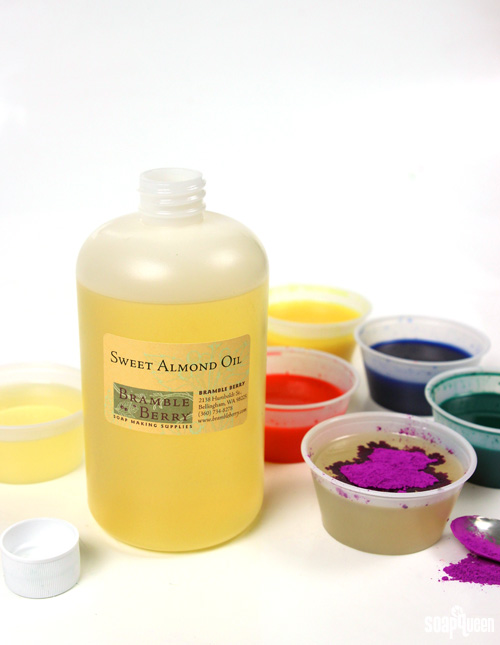 Sweet almond oil is produced by pressing the kernels of almond trees, and is known for its rich concentration of essential fatty acids. Sweet almond oil is produced from the same type of almonds you consume, and is full of vitamin A, E and B2. It has a shelf life of six to twelve months, and can be used in cold process soap up to 20%.
Sweet almond oil is produced by pressing the kernels of almond trees, and is known for its rich concentration of essential fatty acids. Sweet almond oil is produced from the same type of almonds you consume, and is full of vitamin A, E and B2. It has a shelf life of six to twelve months, and can be used in cold process soap up to 20%.
Sweet almond oil is not to be confused with bitter almond oil, which is produced from a different type of almond tree and is considered an essential oil. Bitter almond oil and sweet almond oil have very different applications. Bitter almond oil is often used for it’s scent and taste, while sweet almond oil is used for its wonderful moisturizing properties. A word of caution: bitter almonds (Prunus amygdalus) contain cyanogenic glucoside amygdalin (phew!) which produces cyanide, so bitter almond oil is to be used with extreme caution in all applications.
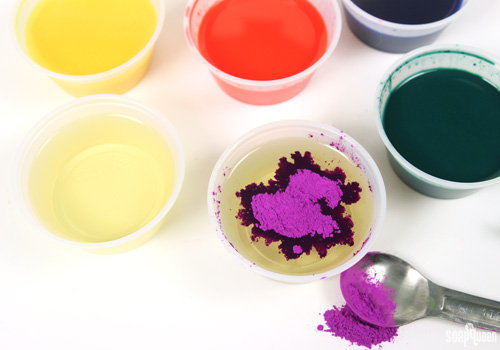 Because of its high fatty acid content, sweet almond oil is a popular ingredient for lip products and scrubs. In the Exfoliating Kisser Tutorial, it’s used alongside avocado oil and sugar to create a product that leaves lips feeling silky smooth. If you are looking for a great lip balm recipe using sweet almond oil, the recipe used in the How to Make Lip Balm video on Soap Queen TV nourishes lips during winter months.
Because of its high fatty acid content, sweet almond oil is a popular ingredient for lip products and scrubs. In the Exfoliating Kisser Tutorial, it’s used alongside avocado oil and sugar to create a product that leaves lips feeling silky smooth. If you are looking for a great lip balm recipe using sweet almond oil, the recipe used in the How to Make Lip Balm video on Soap Queen TV nourishes lips during winter months.
Because the oil absorbs quickly, it leaves skin feeling hydrated and incredibly soft. In the Emulsified Sugar Scrub Tutorial, sweet almond oil is emulsified with water and Natural Liquid Soap to create a creamy product. If you are looking for an easier scrub recipe, the Sweet Summer Scrub made with sweet almond oil and Foaming Bath Whip is perfect for anytime of the year.
 Top row: How to Make Lip Balm on Soap Queen Tv, Exfoliating Kisser Scrub
Top row: How to Make Lip Balm on Soap Queen Tv, Exfoliating Kisser Scrub
Bottom row: Sweet Summer Scrub Tutorial, Emulsified Sugar Scrub (from Scratch) on Soap Queen Tv
The lightweight texture of sweet almond oil works well in other skin care products such as lotion and shaving cream. In the Fresh Face Lavender & Aloe Lotion, as well as in the Handmade Lotion Soap Queen TV video, it creates a non-greasy, hydrating product. Sweet almond oil is added to the Green Tea Shaving Cream to help keep skin comfortable while shaving.
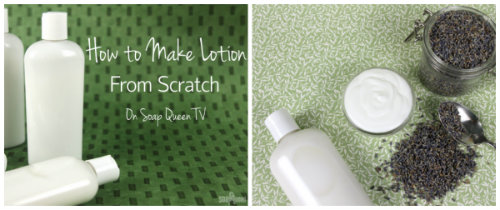
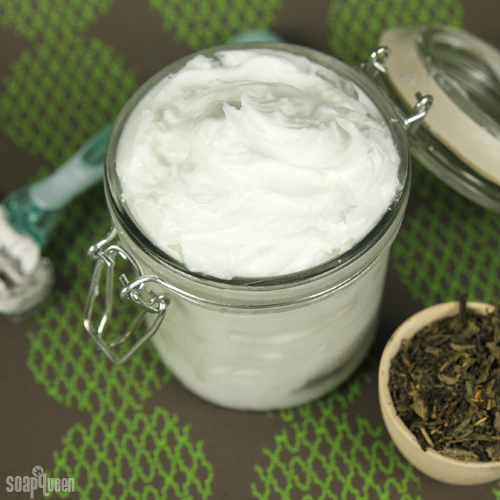 Top row: How to Make Lotion from Scratch on Soap Queen Tv, Fresh Face Lavender & Aloe Lotion
Top row: How to Make Lotion from Scratch on Soap Queen Tv, Fresh Face Lavender & Aloe Lotion
Bottom row: Green Tea Shaving Cream
Sweet almond oil is a fantastic option for dispersing colorants for cold process due to its light consistency and color. When dispersing micas and oxides for cold process soap, use a usage rate of 1 tbs. oil to 1 tsp. colorant. If you’d like more information regarding how to prepare colorants for cold process soap, check out the Soap Queen video below! In addition to sweet almond oil, sunflower oil and canola oil are other popular options to disperse pigments.
Learn to Prepare Colorants for Cold Process Soapmaking from Soap Queen on Vimeo.
In addition to dispersing pigments, sweet almond oil is an excellent choice when infusing oils with herbs. In the video below, sweet almond oil is infused with calendula petals to produce an oil that contains extra soothing properties. This oil can then be used to make a lip balm as shown in the video, or in massage oils as shown in this Baby Massage Oil Soap Queen TV video.
How to Make Infused Lip Balm from Soap Queen on Vimeo.
Do you enjoy using sweet almond oil in your recipes? I would love to hear your thoughts, as well as any sweet almond oil usage suggestions! =)
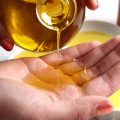
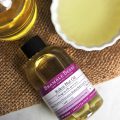

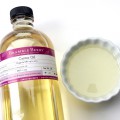
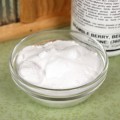
Hello. I have been a bit confused about bitter almond. I read in Anne Marie’s book that you should never use the EO in soap. Then I noticed a big company that has an almond scented bar, and they claim to only use essential and not synthetic fragrances. I asked them and they said they use bitter almond.
So I am not sure if it is to be avoided or not or a matter of opinion?
Gina
Hi Gina!
We recommend not using bitter almond essential oil in soap because bitter almonds contain cyanogenic glucoside amygdalin, which produces cyanide.
We did a lot of research and determined we didn’t feel safe using it. If you feel comfortable, you can. I would recommend researching it thoroughly before making your decision. 🙂
-Kelsey with Bramble Berry
The stuff I often find has the cyanide producing substance removed so I figure as long as you don’t use too much you should be fine.
Thanks so much for your comment! We love using sweet almond oil in our recipes because it feels great on the skin. You can definitely use the bitter almond if you like, as long as it’s safe! 🙂
-Kelsey with Bramble Berry
This post has perfect timing for me! I just ordered some sweet almond oil that should be arriving any day now in my BB order! I’ve never used it before; I want to make a calendula (also in the order) infused baby oil with it for a friend with two little ones. Thanks for the post!
Hi Olivia!
I’m so happy you like the post! Have fun making the baby oil. That sounds like such a great gift. 🙂
-Kelsey with Bramble Berry
Great post! Do people with nut allergies react to sweet almond oil?
Hi Evie!
So glad you like the post! Also, people with nut allergies may be sensitive to this oil, so you’ll want to keep that in mind.
Avocado oil or canola oil are lightweight and moisturizing oils and would work well as replacements for sweet almond oil. I’ll include a link that has more information about that. 🙂
-Kelsey with Bramble Berry
Free Beginner’s Guide to Soapmaking: Common Soapmaking Oils: http://www.soapqueen.com/bath-and-body-tutorials/tips-and-tricks/free-beginners-guide-to-soapmaking-common-soapmaking-oils/
Avocado oil: https://www.brambleberry.com/Avocado-Oil-P3198.aspx
Canola oil: https://www.brambleberry.com/Canola-Oil-P5548.aspx